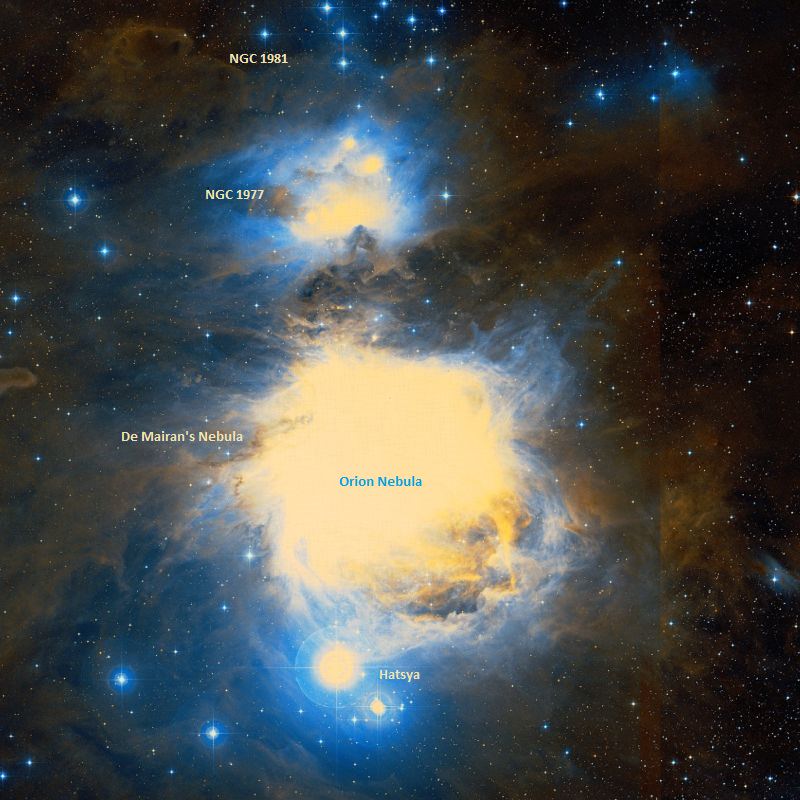Welcome back to Messier Monday! In our ongoing tribute to the great Tammy Plotner, we take a look at Orion's Nebula's "little brother", the De Marian's Nebula!
During the 18th century, famed French astronomer
Charles Messier
noted the presence of several "nebulous objects" in the night sky. Having originally mistaken them for comets, he began compiling a list of them so that others would not make the same mistake he did. In time, this list (known as the
Messier Catalog
) would come to include 100 of the most fabulous objects in the night sky.
One of these if the diffuse nebula known as the De Marian's Nebula (aka. Messier 43). Located in the direction of the Orion constellation (in close proximity to the Orion Nebula), this nebula lies at a distance of 1,600 light years from Earth. Together with the Orion Nebula, it is part of one of the most active star-forming regions visible in the night sky.
Description:
The diffuse nebula M43 surrounds the variable star N U Orionis (HD 37061) - a rather cool, young star cooking in a rich HII region. But is the light that's reaching us actually coming through a tunnel in this dusty cloud? As Karl Wurm and
Mario Perinotto
explained in a
1970 study
:
[caption id="attachment_135667" align="aligncenter" width="580"]
De Mairan's Nebula, M43, NGC 1982. Credit: NASA/ESA/M. Robberto (Space Telescope Science Institute/ESA)/Hubble Space Telescope Orion Treasury Project Team
[/caption]
However, N U is far from being alone.... The whole complex is littered with stars being born! As Bo Reipurth (et al), stated in a
1999 study
:
History of Observation:
In 1731, Jean-Jacques Dortous de Mairan was the first to notice this independent portion of the Orion nebula, stating:
On March 4, 1771, Charles Messier would also come to the same conclusion as he states in his observing notes:
[caption id="attachment_135668" align="aligncenter" width="580"]
Close-up view of the Orion Nebula's little brother, Messier 43, taken by NASA/ESA Hubble Space Telescope. Credit: ESA/Hubble & NASA
[/caption]
While Sir William Herschel was very careful not to assign his own catalog numbers to Messier Objects, he, too, was fascinated by the M43 region. In his personal notes he writes:
May this wonderful region entertain your brain for as many years as it did Bill Herschel!
[caption id="attachment_135669" align="aligncenter" width="467"]
The location of Messier 43 in the constellation of Orion. Credit: IAU/Sky & Telescope magazine (Roger Sinnott & Rick Fienberg)
[/caption]
Locating Messier 43:
Locating M43 is as easy as locating... well... M42! This small star cluster accompanied by an emission/reflection nebula just to the north of the Orion Nebula's "Trapezium" region is often mistake for part of the great nebula itself. However, if you look closely, you'll see the two are separated by a dark dust lane.
Begin by locating the asterism of three stars known as Orion's Belt. If you cover it with your fist held at arm's length in a "thumb's down" gesture with your left hand, the tip of your thumb will just about mark the correct spot in the sky. From a dark location when no Moon is present, you can easily see the haze of the Orion nebula surrounding the stars in the "sword" asterism. While it is easily seen in binoculars on a dark night, it will fade significantly under light pollution or moonlight.
And here are the quick facts on Messier 43 to help you get started:
- Object Name
-
Messier 43
- Alternative Designations
-
M43, NGC 1982, De Mairan's Nebula, Companion of the Orion Nebula
- Object Type
-
Emission/Reflection Nebula and Open Cluster
- Constellation
-
Orion
- Right Ascension
-
05 : 35.6 (h:m)
- Declination
-
-05 : 16 (deg:m)
- Distance
-
1.3 (kly)
- Visual Brightness
-
9.0 (mag)
- Apparent Dimension
-
20x15 (arc min)
We have written many interesting articles about Messier Objects here at Universe Today. Here's Tammy Plotner's
Introduction to the Messier Objects
, ,
M1 – The Crab Nebula
,
M8 – The Lagoon Nebula
, and David Dickison's articles on the
2013
and
2014
Messier Marathons.
Be to sure to check out our complete
Messier Catalog
. And for more information, check out the
SEDS Messier Database
.
Sources:
- Messier Objects - Messier 43
- SEDS - Messier 43
- *Wikipedia - Messier 43*
 Universe Today
Universe Today
